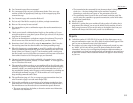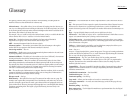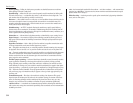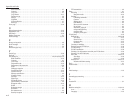
Just in case …
Secure polling — Polling in which preset passcodes are checked between two machines
before polling is allowed to take place.
Speed-dialing — Allows the fax user to store frequently used fax numbers for dialing with
the touch of three keys — an identifier key (either * or #) and then a three-digit code — for
each number. See also Autodialing and One-touch dialing.
Station
ID
— (Also called Location
ID
or Receiver
ID
.) An autodialer feature which lets the fax
user enter a descriptive name to correspond with the number in an autodialer entry. For
example, rather than entering only 1-972-555-3465, the user can enter that number and a
name, such as Dallas Branch Office.
Subaddressing — An ITU-T standard allowing fax machines to specify special delivery
characteristics of a transmission. For example, subaddressing allows fax machines from dif-
ferent manufacturers to send and receive messages into confidential memory mailboxes, or to
retrieve specific files from polling memory.
Subscriber
ID
— A fax machine’s telephone number, as identified by a user setting. See
TTI
.
Super Group 3 — An extension of Group 3 fax technology standards, allowing the use of
high-speed v.34 bis modems for 33.6 Kbps transmission and high-speed protocols for rapid
handshaking.
Superfine resolution — 203
H
× 392
V
lpi. Your fax machine’s superfine transmission mode
is Group-3-compatible, not the more limited proprietary version.
TAD
— Telephone answering device, or answering machine. Records incoming voice messages
for playback. You can connect a
TAD
to your fax machine and use the two on one phone line.
TCR
— Transmit confirmation report; this provides proof that your fax did send the document
you set for transmission. Printed after transmission, the
TCR
also identifies the telephone
number to which the fax sent the document, plus the actual time of transmission and how
many pages the unit transmitted.
Thermal (paper) printing — A thermal head heats chemically treated, thermally sensitive
paper in patterns conforming to the image the machine has scanned, creating a printed
image. Thermal paper’s tendency to discolour and fade, in addition to its curliness and the
usual difficulty in writing on it, have made this method considerably less popular than plain-
paper fax printing — particularly as plain-paper fax machines have dropped sharply in price.
TTI
— Transmit terminal identifier. A user-programmable line of information sent automati-
cally with every page a fax machine sends; it appears at the top of each page printed by the
receiving unit.
Transmission speed — How fast a fax machine is sending a fax document. This speed
depends upon the modem speed of each unit, the resolution setting, the content of the docu-
ment, the encoding technique and the condition of the phone line (clean, noisy, etc.) Any
change in any one of these five conditions will affect the speed, sometimes significantly.
V
.29 and v.27 ter — A standard set of communication procedures allowing fax machines to
talk to other units using those standards. Specifically, these standards cover fax transmission
at 9600 bps or slower.
V
.34 — An international standard for fax modems — and other modems — with transmission
speeds of up to 36.6 Kbps. It represents the current maximum standard transmission speed
possible under ITU-T Group 3.
White-line skip — A technique used to speed up fax transmission by bypassing redundant
areas, such as white space.
5.20


















